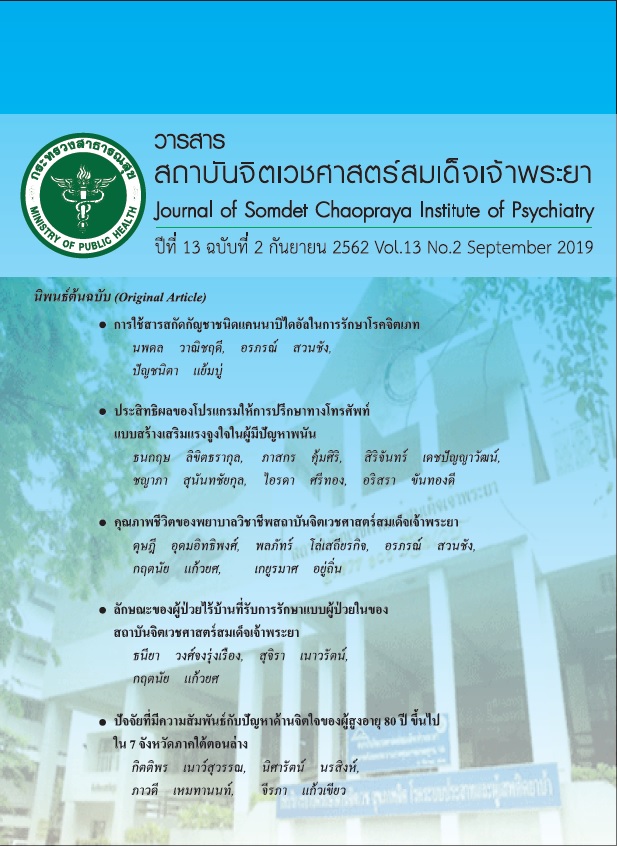การใช้สารสกัดกัญชาชนิดแคนนาบิไดอัลในการรักษาโรคจิตเภท
คำสำคัญ:
กัญชา, แคนนาบินอยด์, แคนนาบิไดอัล, ซีบีดี, โรคจิตเภทบทคัดย่อ
วัตถุประสงค์ : เพื่อทบทวนหลักฐานเชิงประจักษ์ในการใช้สารสกัดกัญชาชนิดแคนนาบิไดอัลในการรักษาโรคจิตเภท
วัสดุและวิธีการ : การศึกษานี้เป็นการทบทวนวรรณกรรมอย่างเป็นระบบ สืบค้นจากฐานข้อมูล Medline, Embase และ Cochrane Library ทำการสืบค้นผลงานวิชาการที่มีการตีพิมพ์ตั้งแต่ปี 2552-2562 เลือกงานวิจัยและบทความวิชาการทุกประเภท ที่ทำการศึกษาในมนุษย์ และมีการตีพิมพ์เป็นภาษาอังกฤษ สืบค้นโดยใช้คำสืบค้น คือ cannabidiol, CBD, schizophrenia และ schizophrenic
ผล : การศึกษาด้านการนำแคนนาบิไดอัลมารักษาผู้ป่วยจิตเภท ณ ปัจจุบัน ยังมีไม่มากนัก จากการสืบข้อมูลอย่างเป็นระบบ เบื้องต้นพบบทความจำนวน 333 บทความ เมื่อทำการทบทวนบทคัดย่อแล้วคัดเลือกเฉพาะบทความที่เกี่ยวข้องเหลือบทความจำนวน 30 บทความ และเมื่อพิจารณาบทความที่เข้าได้กับเกณฑ์คัดเข้าทำให้เหลือบทความที่เกี่ยวข้องจำนวน 4 บทความ ซึ่งผลการศึกษามีความแตกต่างกัน บางการศึกษาพบว่า CBD สามารถลดอาการทางจิตดีขึ้นเทียบเท่ายาต้านโรคจิตอะมิซัลไพร์ด แต่อีกหลายการศึกษาพบว่าไม่สามารถลดอาการทางจิตได้ อย่างไรก็ตามการศึกษาส่วนใหญ่แสดงให้เห็นว่า CBD มีความปลอดภัยและเกิดอาการไม่พึงประสงค์ไม่แตกต่างจากยาหลอก
สรุป : ประสิทธิภาพของแคนนาบิไดอัลในการรักษาผู้ป่วยจิตเภทยังมีหลักฐานเชิงประจักษ์ไม่ชัดเจนพอ เนื่องจากที่ผ่านมามีการศึกษาเรื่องดังกล่าวค่อนข้างน้อย และมีข้อจำกัดของการศึกษาวิจัย คือ กลุ่มตัวอย่างที่ใช้ในการศึกษามีจำนวนน้อย รวมทั้งระยะเวลาในการติดตามผลการรักษาค่อนข้างสั้น อย่างไรก็ตามจากหลักฐานปัจจุบันพบว่า CBD มีความปลอดภัยค่อนข้างมากแม้จะใช้ในขนาดที่สูง แต่ผลดังกล่าวมาจากการศึกษาระยะสั้น ซึ่งจำเป็นต้องติดตาม เฝ้าระวังและศึกษาความปลอดภัยจากการใช้ในระยะยาวต่อไป
เอกสารอ้างอิง
Department of Medical Service. Guidance of Cannabis for Medical Use: Ministry of Public Health, Thailand; 2019. [online]. Available from: http://webdms2.isgateway.com/backend/Content/Content_File/Old_Content/dms2559/download/Final_Guidance.pdf. [2019 Aug 15].
ระพีพงศ์ สุพรรณไชยมาตย์, โชษิตา ภาวสุทธิไพศิฐ. ประโยชน์และโทษที่อาจเกิดขึ้นจากการใช้กัญชาในทางการแพทย์และการเปิดเสรีการใช้กัญชา. วารสารวิจัยระบบสาธารณสุข 2561; 12(1): 72-90.
Madras BK. Update of Cannabis and its medical use 2015. [online]. Available from: https://www.who.int/medicines/access/controlled-substances/6_2_cannabis_update.pdf. [2019 Jun 12].
Lewis MM, Yang Y, Wasilewski E, Clarke HA, Kotra LP. Chemical profiling of medical cannabis extracts. ACS Omega 2017; 2(9): 6091-103.
Pagotto U, Marsicano G, Cota D, Lutz B, Pasquali R. The emerging role of the endocannabinoid system in endocrine regulation and energy balance. Endocr Rev 2006; 27(1): 73-100.
Ashton JC, Wright JL, McPartland JM, Tyndall JD. Cannabinoid CB1 and CB2 receptor ligand specificity and the development of CB2-selective agonists. Curr Med Chem 2008; 15(14): 1428-43.
Bhattacharyya S, Morrison PD, Fusar-Poli P, Martin-Santos R, Borgwardt S, Winton-Brown T, et al. Opposite effects of 9-tetrahydrocannabinol and cannabidiol on human brain function and psychopathology. Neuropsychopharmacology 2010; 35(3): 764-74.
Ligresti A, De Petrocellis L, Di Marzo V. From phytocannabinoids to cannabinoid receptors and endocannabinoids: pleiotropic physiological and pathological roles through complex pharmacology. Physiol Rev 2016; 96(4): 1593-659.
Bhattacharyya S, Wilson R, Allen P, Bossong M, Appiah-Kusi E, McGuire P. Effect of cannabidiol on symptoms, distress and neurophysiological abnormalities in clinical high-risk for psychosis patients: A placebocontrolled study. Schizophrenia bulletin 2018; 44: S28.
Leweke FM, Rohleder C, Müller JK, Hirjak D, Meyer-Lindenberg A. Enhancing recovery in early schizophrenia by randomized controlled addon of cannabidiol to an individualized antipsychotic treatment. Nervenheilkunde 2018; 37(5): 319-23.
Leweke FM, Hellmich M, Kranaster L, Koethe D. Cannabidiol as a new type of an antipsychotic: Results from a placebo-controlled clinical trial. Biological psychiatry 2012; 71(8): 63S.
WHO. CANNABIDIOL (CBD) critical review report: expert committee on drug dependence fortieth meeting; 2018. [online]. Available from: https://www.who.int/medicines/access/controlledsubstances/CannabidiolCriticalReview.pdf. [2019 Jun 1].
Harvey DJ, Samara E, Mechoulam R. Comparative metabolism of cannabidiol in dog, rat and man. Pharmacol Biochem Behav 1991; 40(3): 523-32.
Lucas CJ, Galettis P, Schneider J. The pharmacokinetics and the pharmacodynamics of cannabinoids. Br J Clin Pharmacol 2018; 84(11): 2477-82.
Leweke FM, Kranaster L, Hellmich M, Koethe D. Cannabidiol as a new type of an antipsychotic: Results from a placebo-controlled clinical trial. Neuropsychopharmacology 2010; 35: S280-S1.
Leweke FM, Piomelli D, Pahlisch F, Muhl D, Gerth CW, Hoyer C, et al. Cannabidiol enhances anandamide signaling and alleviates psychotic symptoms of schizophrenia. Transl Psychiatry 2012; 2: e94.
Boggs DL, Surti T, Gupta A, Gupta S, Niciu M, Pittman B, et al. The effects of cannabidiol (CBD) on cognition and symptoms in outpatients with chronic schizophrenia a randomized placebo controlled trial. Psychopharmacology 2018; 235(7): 1923-32.
McGuire P, Robson P, Cubala WJ, Vasile D, Morrison PD, Barron R, et al. Cannabidiol (CBD) as an adjunctive therapy in schizophrenia: A multicenter randomized controlled trial. Am J Psychiatry 2018; 175(3): 225-31.
Zuardi AW, Hallak JE, Dursun SM, Morais SL, Sanches RF, Musty RE, et al. Cannabidiol monotherapy for treatment-resistant schizophrenia. J Psychopharmacol 2006; 20(5): 683-6.
Hallak JE, Machado-de-Sousa JP, Crippa JA, Sanches RF, Trzesniak C, Chaves C, et al. Performance of schizophrenic patients in the Stroop Color Word Test and electrodermal responsiveness after acute administration of cannabidiol (CBD). Revista brasileira de psiquiatria (Sao Paulo, Brazil : 1999) 2010; 32(1): 56-61.
ดาวน์โหลด
เผยแพร่แล้ว
รูปแบบการอ้างอิง
ฉบับ
ประเภทบทความ
สัญญาอนุญาต
บทความที่ได้รับการตีพิมพ์เป็นลิขสิทธิ์ของวารสารสถาบันจิตเวชศาสตร์สมเด็จเจ้าพระยา



